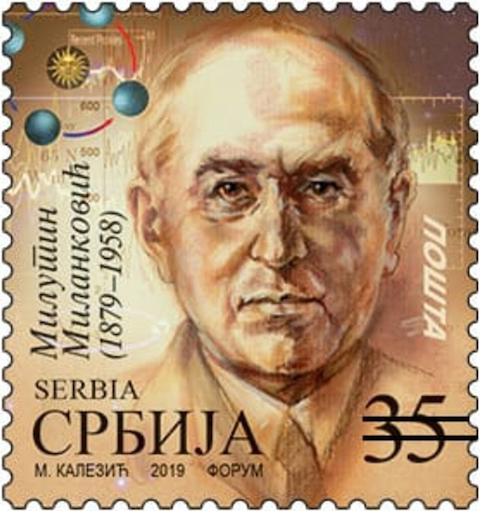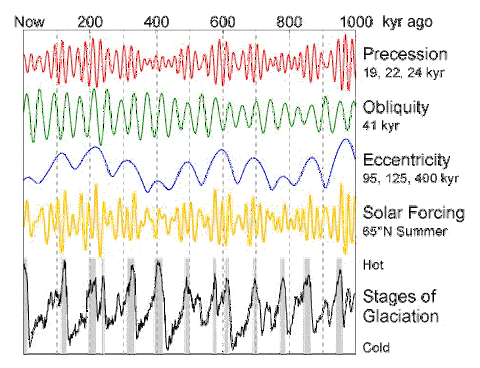
At the start of the 20th century, Serbian mathematician and physicist Milutin Milanković decided to use math to determine how Earth’s ice ages had occurred.
First, he calculated how the amount of sun that Earth receives—its insolation—determines its temperature.
Then, he identified and explained Earth’s different climate zones based on their insolation.
Finally, he built a mathematical model to discover if Earth’s insolation is affected by three variations: a changing elliptical path around the Sun; a change in the tilt of Earth’s axis; and a wobble on that axis.
Though they cycle at vastly different time intervals, Milanković wondered if these variations could be shaping Earth’s long-term climate.
He worked the problem out with pen and paper while under house arrest during World War I, demonstrating how these cyclical variations interacted to reduce or amplify the effects of insolation, causing long cooler glacial and shorter warmer interglacial periods.
Milanković had calculated back 600,000 years, and his results lined up exactly with the geological record!
With this work, he founded the science of planetary climatology, modeling the climate of Earth and other planets over 100 years ago. His work is the basis of modern weather forecasting.
Human civilization developed in the most recent warm interglacial period of the last 10,000 years. But one day again, the ice man cometh!
Background
Synopsis: Milutin Milanković pioneered the transition of empirical, descriptive sciences into exact sciences through the language of mathematics. His curiosity about past ice ages led this early-20th-century Serbian scholar to deduce and then hand-calculate the linkage of Earth’s long-term climate variation to astronomical cycles impacting the amount of solar energy reaching the planet. These cycles are now known as Milanković Cycles. He then estimated atmospheric conditions for other planets in the solar system, founding the science of planetary climatology. He did much of his foundational work while interred in prison and under house arrest during World War I.
- Milutin Milanković was a remarkable Serbian mathematician, engineer, and scientist.
- He was born May 28, 1879, in the Austro-Hungarian village of Dalj, which is now in Croatia, along the Danube River at the border with Serbia.
- His Serbian family was wealthy, enabling him to travel to study engineering at Technische Universität Wienin Vienna at age 17.
- At 25, he earned a Ph.D. for his research on concrete structures. He went on to work as an engineer, designing reinforced concrete dams, bridges, and aqueducts in the region and patenting his new approaches.

- In 1909, at age 30, Milanković was offered the chair of applied mathematics (which included the fields of classical mechanics and theoretical physics) at the University of Belgrade, Serbia’s largest and oldest university.
- He had a passion for teaching others and was well liked as a professor but wanted to make his mark in fundamental research.
- Many sciences of the day were descriptive, and Milanković saw an opportunity to explain them with mathematics, so he went looking for a problem to solve.
- He was most intrigued by the mystery of the ancient ice ages that had left evidence of their existence in the nearby Alps. Previous scientists had suggested that astronomical cycles might have influenced climate to cause the ice ages, but they could not prove it.
- Milanković thought the mathematics of spherical geometry, celestial mechanics, and theoretical physics might explain how systematic astronomical variations influence climatic variations. In 1912, he began working on the problem.
- His first work in 1912 described how the Sun’s rays determine Earth’s temperature after they pass through the atmosphere. His second work in 1913 correctly explained Earth’s climate zones based on the calculated intensity of solar insolation.
- By 1914, he had outlined his plan to develop a mathematical theory that connected thermal regimes on planets to their orbits around the Sun, enabling predictions of future climate on Earth as well as predicting climate conditions on other planets.
- He started on his grand plan with a paper, “About the issue of the astronomical theory of ice ages” in 1914, but his work was suddenly interrupted.
- In July 1914, Milanković honeymooned with his wife in his birthplace, the village of Dalj in Austro-Hungary.
- Just two weeks later, World War I broke out. As a Serbian citizen, Milutin was arrested and taken to an Austrian fortress as a prisoner of war.
- The night of his arrest, he realized he had his research works and blank paper in his luggage, so he began his long-hand astronomical calculations right then and there.
- Soon, his wife persuaded one of his mentors to arrange for his release from prison and for permission for Milanković to work under house arrest from the library of the Hungarian Academy of Science in Budapest for the 4-year duration of the war.
- During his interment, Milanković published “Investigation of the climate of the planet Mars,” complete with predictions of harsh Martian atmospheric conditions. He described climatic conditions on Mercury and Venus and predicted temperatures on the Moon that were directionally correct.
- In 1919, after the end of the war, he returned to Belgrade and published the book, Mathematical Theory of Heat Phenomena Produced by Solar Radiation, which became one of the foundational works for modern weather prediction.
- Milanković’s approach to astronomical effects on Earth’s climate focused on the Sun as the sole source of light and heat energy in our solar system and considered the interaction of three cycles of Earth movement.
- Each of these cycles alter the amount of heat impinging on a particular point on Earth, a measurement known as insolation.
- One cycle—eccentricity—is related to the shape of Earth’s orbit around the sun, whereas the other two cycles are related to the change in tilt—obliquity—and wobble—precession—of Earth’s rotational axis.
- Because the three cycles have different time scales, Milanković knew that at times they would interact constructively to boost insolation, and at other times they would interfere destructively to diminish it.
- He set about to show how these cycles could drive Earth’s climatic patterns through a meticulous long-hand calculation based on this simple rationale.
- After years of exhaustive calculations and investigations, he determined the variation in insolation for different Earthly latitudes. In 1930, he published Mathematical Climatology and the Astronomical Theory of Climate Change.
- He theorized that when summers were short and cool, winter snow would linger over the years and accumulate into glaciers, further cooling the region as the bright snow reflected solar radiation.
- He expected that when insolation was lower at higher latitudes, ice ages could get their start in areas where there were large landmasses that could accumulate snow. He predicted ice ages would peak when the orbital cycles interfered to decrease high-latitude insolation.
- He calculated the cycles for 600,000 years to start, but needed to ground truth his predictions with precisely timed geological records of glaciations.
- 50 years later, deep-sea sediment cores supported the timing he predicted for five shifts.
- South Pacific fossil corals undergoing active uplift recorded sea-level changes that enabled the precise timing of ice ages and matched Milanković’s predictions.
- Other cycles and variables also influence the finer points of climatic changes, but the three orbital variations used in Milanković’s hand calculations provided an important step forward in the numerical modeling of Earth systems.

- Milanković retired from the University of Belgrade after 46 years and died on December 12, 1958, in Belgrade, Yugoslavia, now Serbia.
- He was always interested in helping non-scientists understand science. In the 1920’s, he wrote a monthly letter to a magazine in Serbia inviting an imaginary friend to join him on journeys to visit past scientists and learn about their ideas. The columns were ultimately published in a 1928 book, Through Distant Worlds and Times: Letters from a Wayfarer in the Universe.
- In 1982, 24 years after his death, the National Research Council of the U.S. National Academy of Sciences lauded his work: “...orbital variations remain the most thoroughly examined mechanism of climatic change on time scales of tens of thousands of years and are by far the clearest case of a direct effect of changing insolation on the lower atmosphere of Earth.”
- Now that we know other planets influence Earth’s orbit, scientists are looking into Earth’s geological record to see what it can tell us about the motions of other planets.

